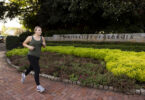Athens, Ga. – Older adults can decrease their risk of disability and increase their likelihood of maintaining independence by 41 percent by participating in a walking exercise program, according to a new University of Georgia study.
The study, which appears in the current issue of the Journal of Geriatric Physical Therapy, also found that walking program participants increased their peak aerobic capacity by 19 percent when compared to a control group and increased their physical function by 25 percent.
“In the past decade, researchers have focused on the benefits of strength training in maintaining independence, but until now we didn’t have good evidence using an objective performance measure that a walking program would improve physical functioning,” said study co-author M. Elaine Cress, professor of kinesiology and researcher in the UGA Institute of Gerontology. “Our study found that walking offers tremendous health benefits that can help older adults stay independent.”
The researchers randomly assigned 26 low-income adults aged 60 and older to either a walking exercise group, which met three times a week for four months, or a nutrition education control group. Initially, the group would walk for 10 minutes continually. As the weeks progressed, they increased their walking time to 40 continuous minutes. Each session began with a 10-minute warm-up and ended with a 10-minute cool-down that included balance and flexibility exercises.
Trudy Moore-Harrison, the lead author of the study and a former UGA doctoral student, explained that the researchers focused their study on low-income individuals because people with fewer financial resources are less likely to be physically active and are more likely to have chronic health conditions and lack health care coverage. Moore-Harrison added that walking doesn’t require any special equipment other than a pair of comfortable shoes, which makes it a simple and low-cost way for people to become active. Moore-Harrison supervised the group, but the researchers said that motivated community members could lead similar groups across the country.
Getting people to stick with exercise programs can be notoriously difficult, but the researchers found that every single member of the group stayed with the program for its four-month duration. “People really enjoyed the program,” said Moore-Harrison, now a post-doctoral fellow at the University of North Carolina Charlotte. “It gave them an opportunity to make new friends and get to know their neighbors.”
The researchers measured the aerobic capacity of the participants using a treadmill test and found that while the control group saw an 9 percent decline in aerobic capacity over the four-month study period, the aerobic capacity of the walking group increased by 19 percent over the same time period.
“Aerobic capacity is really the engine that we draw upon for doing the things we want to do, whether it’s cleaning up around the house or running a marathon,” Cress said. “By increasing their aerobic capacity, the walking group was better able to perform their daily tasks and had more energy left over for recreational activities, like going out dancing.”
The researchers assessed health status and bodily pain through questionnaires and examined disability by measuring performance on factors such as balance and walking. Physical functioning was measured through both questionnaires and through tests that measured how well the volunteers performed daily activities such as climbing a flight of stairs and putting on and removing a jacket.
The researchers found that physical function increased by 25 percent in the walking exercise group, compared to a decrease of 1 percent in the control group. And while the control group saw their risk of disability increase over the four-month period, the walking exercise group saw their disability risk go from 66 percent to 25 percent – a decrease of 41 percent in just four months.
“We know that walking is good for you, but too many people still aren’t doing it,” Moore-Harrison said. “This study shows that just walking on a regular basis can make a huge impact on quality of life.”
The research was supported by the UGA Institute of Gerontology Seed Grant, the Northeast Georgia Area Agency on Aging and the Georgia Gerontology Consortium Seed Grant. The research was done in cooperation with the Athens Housing Authority.







